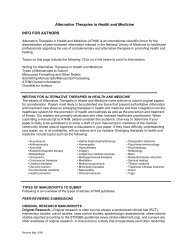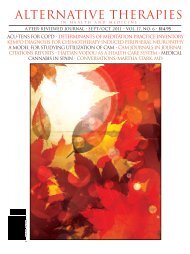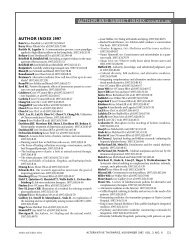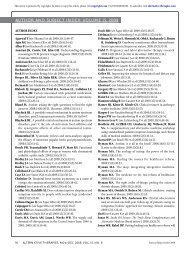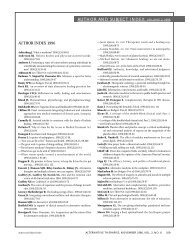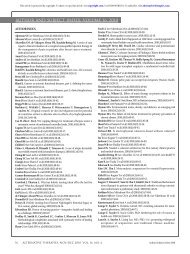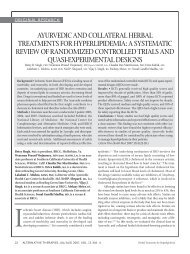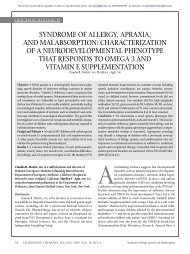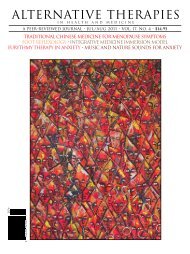Alternative Therapies In Health And Medicine
Alternative Therapies In Health And Medicine
Alternative Therapies In Health And Medicine
Create successful ePaper yourself
Turn your PDF publications into a flip-book with our unique Google optimized e-Paper software.
and its character. Such rapid improvement is less likely due to an<br />
ongoing counseling already proceeding for months, though it might<br />
still have contributed to the improvement. Similar considerations<br />
may also apply to the AM medication before and during EYT. <strong>In</strong><br />
systematic reviews, herbal intervention was not found to be very<br />
effective for anxiety. 28 Massage and resting before EYT may have<br />
contributed to the relaxant effect of EYT but did not cause it alone,<br />
since the patient was still tense at the beginning of the EYT session.<br />
Improvement of the anxiety solely due to spontaneous course<br />
of disease is unlikely in view of the described dynamic of the clinical<br />
picture and complaints. Particularly, it could not explain the repeatedly<br />
observed immediate improvements in the patient’s movement<br />
and gesture patterns when doing the specifically corresponding<br />
EYT exercises. Furthermore, anxiety disorder is a chronic disease,<br />
and spontaneous remission is not common: in controlled clinical<br />
trials, untreated patients with anxiety disorders did not show substantial<br />
improvement of the anxiety symptoms. 30 <strong>In</strong> addition, context<br />
effects may have influenced the course of disease, but they<br />
would be regarded as an integral part of the total AM approach. 31<br />
A limitation of the case report is the lack of a formal instrument<br />
to assess the severity of the disease and its improvement during<br />
follow-up. However, this case was drawn from a routine primary<br />
outpatient setting and therefore mirrors medical reality. Some of<br />
the available questionnaires used in clinical research may also be<br />
useful for clinical practice and facilitate a more quantitative<br />
assessment. 32-35 Still, as anxiety is a subjectively experienced illness,<br />
the personal account of the patient is what matters in the end.<br />
<strong>In</strong> this patient, anxiety did substantially improve but was not<br />
completely resolved. Anxiety is a chronic disease, and 6 years after<br />
the treatment period, the patient reported relapses and underwent<br />
treatments with cognitive therapy, Sertraline, and EYT. Again, EYT<br />
was helpful. Altogether, the anxiety relapses became less intense,<br />
and the patient now is able to fully participate in social life.<br />
This clinical observation from a routine practice is concordant<br />
with the results of a major 2-year prospective cohort study conducted<br />
in Germany that evaluated AM therapies in chronic diseases in<br />
141 AM practices. Sixty-four patients with anxiety disorder were<br />
included, 33 of whom had been treated with EYT as primary treatment.<br />
These consecutively treated and prospectively documented<br />
patients showed a statistically significant and long-term improvement<br />
of symptoms and of quality of life (Figure). 22<br />
Compared to that study, the present report goes into more<br />
detail about the concept and the implementation of EYT. It suggests<br />
that properly applied, EYT can be helpful for anxiety patients who<br />
have a preference for nonverbal and artistic therapies; do not<br />
improve with standard therapy; find these therapies to be too passive<br />
(anti-anxiety medication), too intrusive, or too verbal (psychotherapy);<br />
or suffer from adverse reactions.<br />
Anxiety disorders are a major health concern with substantial<br />
impairment of quality of life. Many patients do not or only temporarily<br />
respond to established treatments and prefer complementary<br />
interventions, particularly nonverbal and artistic approaches. Since<br />
EYT shows promising results for this indication, further studies<br />
should be conducted.<br />
dexterity prevail, along with a predominant differentiation of<br />
the nerve-sense-system. During the second 7-year period, the<br />
growing awareness of the child’s own emotions and increasing<br />
experience of his or her own separate inner world prevails,<br />
along with a differentiation of the rhythmic system (eg,<br />
the pulse/breathing ratio 39 ). During the third period, the<br />
development of free will and autonomous personality (adulthood)<br />
prevails, accompanied by the final differentiation of<br />
the motor-metabolic system, starting with the sexual maturation<br />
at the beginning of this period.<br />
Specific vulnerabilities are seen in these periods. For<br />
example, in the second 7-year period, the child is often sensitive<br />
to outer pressure and reacts with symptoms in the metabolic<br />
system (stomachache) and/or the nerve-system<br />
(headache) since the rhythmical system is not yet strong<br />
enough to balance the two other system constituents. <strong>In</strong> this<br />
period, the rhythmical system’s own disturbances need not<br />
result in grossly anatomical defects but rather in mental/<br />
emotional symptoms (eg, depression or anxiety 40-42 ).<br />
IV. Dislocative Pathogenesis 43 and the Breathed-inupwards<br />
Syndrome<br />
As a matter of pathogenesis, the region-specific types of<br />
the four-level interrelations can be dislocated into other areas of<br />
the organism. For instance, the specific type of the four-level<br />
interrelations that accompanies the lung process of inspiration<br />
can shift towards the upper regions of the organism (breast,<br />
neck and head). <strong>In</strong> such a case, one will encounter a pathological<br />
state, which is called the breathed-in-upwards syndrome in<br />
the present article. 44<br />
This dislocation finds its expression in the respective person<br />
as being alert, light, lively, engaged; when more intensified,<br />
the person becomes wound up, tense, overexcited, uneasy, and<br />
nervous. <strong>In</strong> an extreme case, one may feel out of control or<br />
even psychotic. With the contrary dislocation (ie, the breathedout-downwards<br />
syndrome), the person would feel like letting<br />
go, centered, grounded, and relaxed; when more intensified,<br />
the person may feel heavy, dull, indifferent, and depressed. <strong>In</strong><br />
extreme cases, the person may lose consciousness.<br />
No adverse effects were observed in our patient. Still, treatment<br />
of patients with EYT should be restricted to trained EYT therapists.<br />
Furthermore, EYT might not be sufficient as a sole treatment,<br />
and other interventions might have to be added or applied later.<br />
Patients should be carefully and regularly monitored by doctors<br />
regarding the course of anxiety as well as potentially overlapping<br />
comorbid disorders.<br />
Conclusion<br />
<strong>In</strong> a patient with stress-induced anxiety, EYT seems to have<br />
been an effective treatment. This case report offers insight into<br />
the anthroposophic conceptualization of life functions and their<br />
pathological deviations and the way they are used for diagnosis<br />
62 ALTERNATIVE THERAPIES, jul/aug 2011, VOL. 17, NO. 4 Eurythmy Therapy in Anxiety TK



